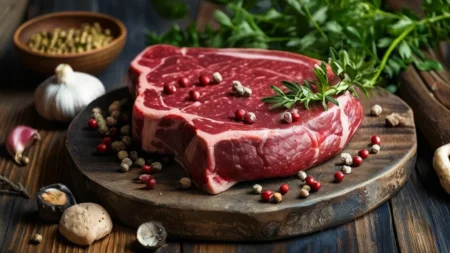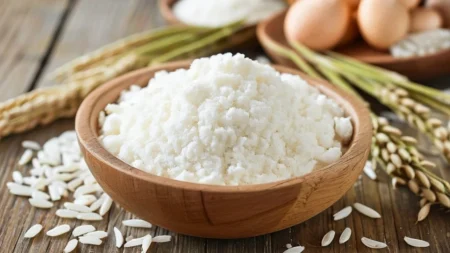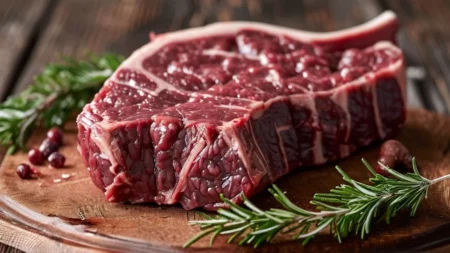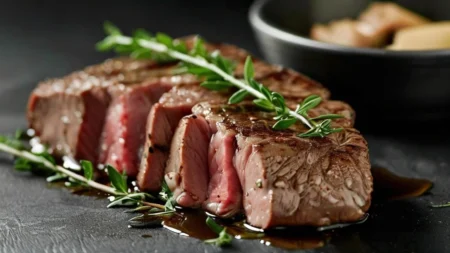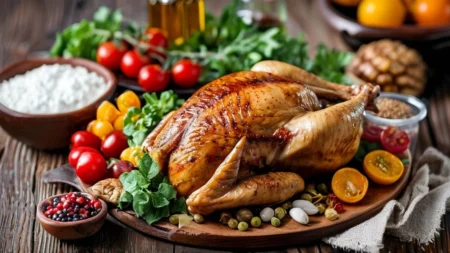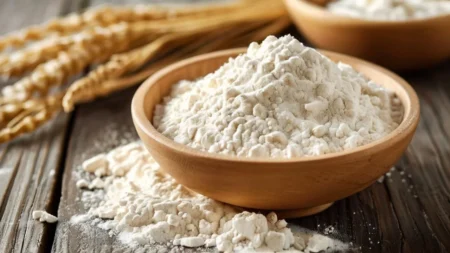Pork: A Versatile Source of Protein Packed with Essential Nutrients
Key Takeaways:
- Pork is a rich source of protein, vitamins, and minerals, particularly B vitamins and selenium.
- Different cuts of pork vary in fat content, making it adaptable for various dietary needs.
- Lean pork can support muscle growth, weight management, and overall health when consumed in moderation.
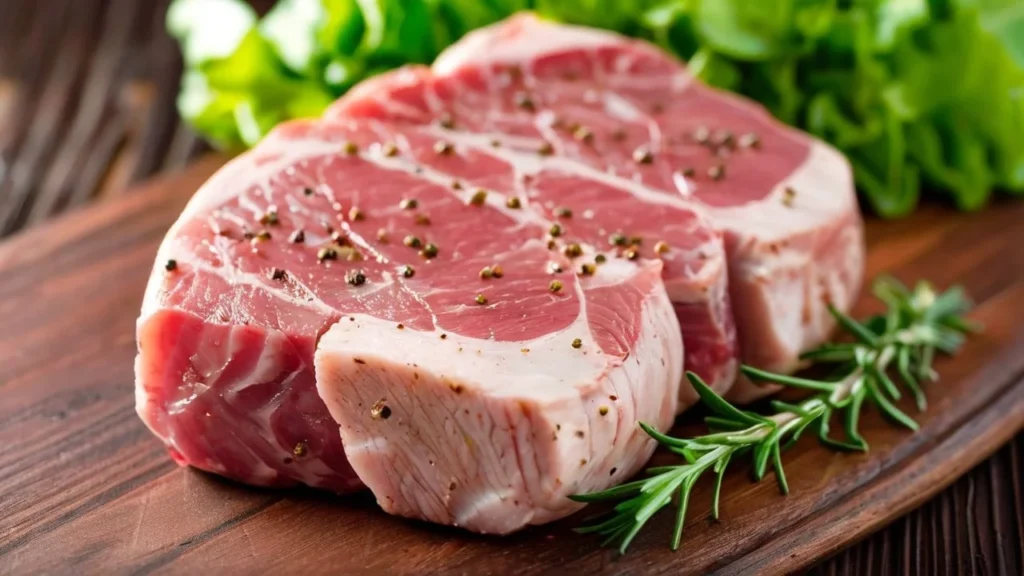
Nutritional Profile of Pork
Pork offers a variety of nutrients essential for maintaining overall health. The nutritional values can vary depending on the cut of pork, with lean cuts being lower in fat and calories. Here’s the nutritional breakdown of 100 grams of cooked lean pork (such as pork loin):
| Nutrient | Amount |
|---|---|
| Calories | 242 kcal |
| Protein | 27 grams |
| Total Fat | 14 grams |
| Saturated Fat | 5 grams |
| Carbohydrates | 0 grams |
| Vitamin B1 (Thiamine) | 0.87 mg (71% DV) |
| Vitamin B6 | 0.5 mg (38% DV) |
| Vitamin B12 | 0.7 mcg (28% DV) |
| Selenium | 45 mcg (82% DV) |
| Phosphorus | 240 mg (34% DV) |
| Zinc | 2.3 mg (21% DV) |
| Iron | 1.3 mg (7% DV) |
High in Protein
Pork is an excellent source of high-quality protein, providing essential amino acids that support muscle growth, repair, and overall body function.
Rich in B Vitamins
Pork is particularly high in B vitamins, including thiamine (vitamin B1), which plays a critical role in energy metabolism, and vitamin B6, important for brain health and immune function.
Health Benefits of Pork
1. Supports Muscle Growth and Maintenance
The high protein content in pork makes it a great option for supporting muscle growth and recovery, particularly after exercise. Lean cuts of pork, such as tenderloin or pork loin, are particularly beneficial for those looking to build or maintain muscle mass.
2. Heart Health (When Choosing Lean Cuts)
While some cuts of pork can be high in fat, choosing lean cuts like pork tenderloin can offer heart-healthy benefits. Lean pork is low in saturated fat, which can help reduce cholesterol levels when consumed in moderation.
3. Boosts Energy Levels
Pork is an excellent source of B vitamins, especially vitamin B1 (thiamine), which helps convert carbohydrates into energy. This makes pork a valuable food for maintaining energy levels throughout the day.
4. Rich in Selenium
Selenium is a trace mineral found in pork that plays a vital role in thyroid function and protecting cells from oxidative stress. A diet rich in selenium can support immune function and overall health.
Popular Cuts of Pork and Their Uses
Different cuts of pork vary in texture, flavor, and fat content, making them versatile in the kitchen. Here’s a look at some of the most popular cuts and their uses:
| Cut | Description | Common Uses |
|---|---|---|
| Pork Loin | A lean cut from the back of the pig, tender and mild in flavor. | Grilling, roasting, stir-fries |
| Pork Tenderloin | The leanest cut of pork, tender and flavorful. | Roasting, grilling, pan-searing |
| Pork Chops | A versatile cut from the loin, available bone-in or boneless. | Grilling, pan-frying, baking |
| Pork Belly | A fatty cut known for its rich flavor and tenderness. | Slow-cooking, braising, making bacon |
| Pork Shoulder | A tougher cut with a higher fat content, perfect for slow cooking. | Pulled pork, stews, carnitas |
| Ham | Cured pork from the leg, available smoked or unsmoked. | Sandwiches, holiday roasts, casseroles |
Pork Loin
Pork loin is a lean and tender cut that is great for grilling or roasting. It’s mild in flavor and pairs well with various marinades and seasonings.
Pork Tenderloin
This is the leanest cut of pork, making it ideal for those looking to reduce their fat intake. Pork tenderloin cooks quickly and can be roasted, grilled, or pan-seared for a delicious, healthy meal.
How to Incorporate Pork into Your Diet
Pork is a versatile ingredient that can be used in a wide variety of dishes, from breakfast to dinner. Here are some ways to enjoy pork:
1. Grilled Pork Chops
Grill pork chops for a quick, flavorful meal. Season with herbs, spices, and a drizzle of olive oil, and serve with a side of vegetables for a balanced dish.
2. Pork Tenderloin Stir-Fry
Pork tenderloin is perfect for stir-fries. Slice the tenderloin into thin strips, sauté with your favorite vegetables, and toss with a savory stir-fry sauce.
3. Pulled Pork
Use pork shoulder to make slow-cooked pulled pork. After several hours of slow cooking, the meat becomes tender and easy to shred, perfect for sandwiches, tacos, or over rice.
4. Pork Breakfast Sausage
Ground pork can be used to make breakfast sausage patties. Add seasonings like sage, thyme, and garlic, and cook in a skillet for a tasty breakfast option.
Pork and Nutritional Considerations
Choosing Lean Cuts
When incorporating pork into your diet, opt for lean cuts like pork tenderloin or pork loin to reduce saturated fat intake. These cuts are just as flavorful and can be used in a wide variety of dishes.
Pork and Cholesterol
Pork, especially fattier cuts, can contribute to higher cholesterol levels if consumed in excess. It’s important to balance your diet with other lean proteins and fiber-rich vegetables to promote heart health.
Sodium Content in Processed Pork
Processed pork products, such as bacon, ham, and sausages, can be high in sodium. While these foods can be enjoyed in moderation, it’s essential to limit their intake to avoid excessive sodium consumption, which can raise blood pressure.
Conclusion
Pork is a nutrient-dense protein source that can be a healthy part of a balanced diet when consumed in moderation and when choosing lean cuts. Whether you enjoy pork chops, tenderloin, or pulled pork, this versatile meat provides essential vitamins and minerals like thiamine, vitamin B6, and selenium. Incorporating pork into a well-rounded diet can support muscle growth, boost energy, and provide heart-healthy benefits when lean cuts are selected.
FAQ
Q: What is the healthiest cut of pork?
A: Pork tenderloin is the healthiest cut of pork, as it is very lean and low in fat. It provides a good source of protein while being lower in calories and saturated fat compared to other cuts.
Q: Can pork be part of a heart-healthy diet?
A: Yes, lean cuts of pork, such as pork tenderloin and pork loin, can be part of a heart-healthy diet. These cuts are low in saturated fat and provide important nutrients like protein, selenium, and B vitamins.
Q: Is pork a good source of iron?
A: While pork does contain some iron, it is not as rich in iron as beef or lamb. However, it still provides a small amount of iron, particularly in darker cuts like pork shoulder.
Q: How can I reduce the fat content in pork dishes?
A: To reduce fat content, choose lean cuts like pork loin or tenderloin and trim any visible fat before cooking. You can also avoid frying and instead opt for grilling, baking, or roasting.
Q: Is pork safe to eat if it’s slightly pink inside?
A: Yes, pork is safe to eat when it reaches an internal temperature of 145°F (63°C) and may still be slightly pink in the center. This temperature ensures the pork is cooked thoroughly and safe to consume.





